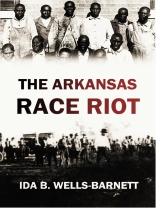‚Elaine, Arkansas became the scene of one of the most violent racial conflicts the country had ever to that time experienced.‘ -Readings in Arkansas Politics and Government (2009)
‚The Arkansas Race Riot amplified…the cowardly penchant of white mobs for singling out the weakest individuals.‘ -Ida B. Wells-Barnett and American Reform (2003)
‚Arkansas authorities convicted 12 black farmers…to death…at this point Ida stepped in.‘ -Ida B. Wells: A Woman of Courage (2010)
‚A massive race riot…near the town of Elaine…between 200 and 250 blacks and at least 4 whites had been killed…67 blacks were sent to prison.‘ -Habeas Corpus: Rethinking the Great Writ of Liberty (2002)
The Elaine, Arkansas race riot occurred on September 30-October 1, 1919, at Hoop Spur in the vicinity of Elaine in rural Phillips County, Arkansas. Although official records of the time state that eleven black men and five white men were killed, estimates of black people killed ranged into the hundreds.
The white mobs were aided by federal troops (requested by Arkansas governor Charles Brough) and vigilante militias like the Ku Klux Klan. According to the Encyclopedia of Arkansas, ‚the Elaine Massacre was by far the deadliest racial confrontation in Arkansas history and possibly the bloodiest racial conflict in the history of the United States‘.
In 1920, Ida Bell Wells-Barnett, investigative journalist and an early leader in the civil rights leader, published an account of the riot and the legal aftermath in a book titled ‚The Arkansas Race Riot.‘
In describing press accounts of the cause of the riot, Wells-Barnett writes:
‚Columns were printed telling of an organization among Negro farmers in this little burg who were banded together or the purpose of killing all the white people, the organization being known as the Farmers‘ Household Union. As a result of these charges over one hundred Negro farmers and laborers, men and women, were arrested and jailed in Helena, Ark., the county seat of Phillips County. One month later they were indicted and tried for murder in the first degree and the jury found them guilty after six minutes of deliberation. Twelve were sentenced to die in the electric chair.‘












